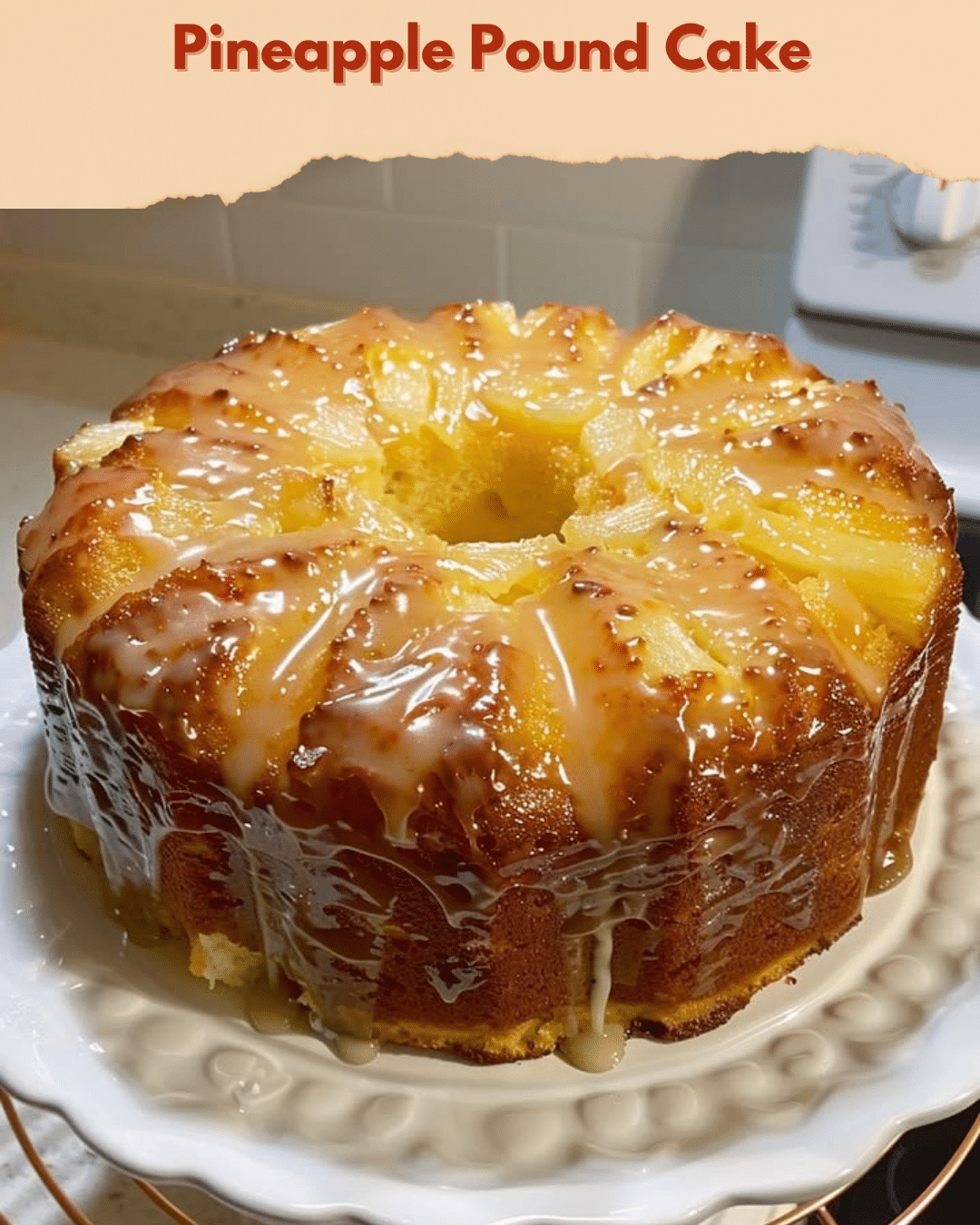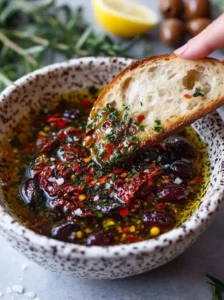Pineapple Pound Cake: A Tropical Delight for Every Occasion
Discover the perfect blend of sweetness and tropical flavors with this Pineapple Pound Cake. This delightful dessert is your ticket to a mini vacation with every bite. Imagine the rich, buttery texture enhanced with juicy pineapple pieces. It’s an easy recipe that will have you dreaming of sandy beaches and sunny days.
The Pineapple Pound Cake combines classic dessert traditions with a refreshing twist. Whether you’re hosting a party, a family gathering, or simply treating yourself, this cake is sure to impress. The tropical aroma and mouthwatering taste of pineapple elevate the cake to a new level. Perfectly moist on the inside with a slightly crispy crust, this cake is a must-try for any dessert lover.
Quick Recipe Highlights
Flavor Profile: The Pineapple Pound Cake is a harmonious balance of sweet and tart. With the buttery richness of the cake and the tangy sweetness of the pineapple, every flavor is delightfully vibrant.
Texture: Experience the perfect blend of a tender crumb paired with juicy pineapple chunks. The cake is moist and light with a delicate crust.
Aroma: The aroma of baked pineapples fills the kitchen, offering hints of caramelized pineapple mixed with vanilla and butter.
Visual Appeal: Golden brown on the outside with bursts of yellow pineapple, this cake catches the eye immediately. The pineapple bits provide a rustic charm to the presentation.
Skill Level Needed: This cake is ideal for novice bakers ready to impress without stress. With simple mixing techniques, anyone can achieve great results.
Special Equipment: All you need is a standard loaf pan and a reliable oven. A mixer will help blend ingredients smoothly, but it’s not essential.
Recipe Overview
Difficulty Level: The Pineapple Pound Cake is simple, making it accessible for all bakers. The recipe involves basic mixing and baking, ensuring successful results even for first-timers.
Category: This delightful dish falls into dessert and snack categories. It’s perfect for afternoon tea or a sweet ending to your dinner.
Cuisine: This recipe borrows from classic American desserts with a tropical twist. Pineapples, celebrated in various cuisines, add a Caribbean flair.
Cost: Economical yet exquisite, the ingredients for Pineapple Pound Cake need minimal investment. Standard pantry staples combined with fresh pineapple keep costs low without sacrificing flavor.
Season: This cake thrives in summertime, aligning with the peak season of pineapples. However, it’s a year-round treat, bringing sunshine to your table even on the dreariest of days.
Occasion: Ideal for birthdays, picnics, or any celebration, this cake becomes a crowd favorite effortlessly. It’s the go-to cake when you need a satisfying yet uncomplicated dessert.
Why You’ll Love This Recipe
The taste and texture of the Pineapple Pound Cake are unmatched. The balance between the buttery cake and the pineapple’s natural sweetness creates a timeless flavor profile that leaves you craving more. The convenience of preparing this cake lies in its straightforward instructions. It requires standard kitchen equipment and no specialized techniques, making it perfect for bakers of all levels seeking an impressive yet manageable dessert.
Nutritionally, the fresh pineapple stands out. Pineapples are rich in vitamins and enzymes, providing a healthy edge to this indulgent cake. From parties to picnics, the Pineapple Pound Cake is a social centerpiece. It’s easy to transport and even easier to serve, ensuring guests delight in its flavors without logistical hurdles.
Cost-effectiveness and ingredient accessibility play a huge role in why this dish remains popular. It brings together common and affordable ingredients, transforming them into a special treat without having to break the bank. Accessible and adaptable, this recipe fits into various dietary needs and personal preferences.
Historical Background and Cultural Significance
The Pineapple Pound Cake brings together influences from multiple cultures. While pound cakes originated in Europe, the introduction of pineapple adds a tropical dimension popularized in American baking over the past century. Pineapples symbolize hospitality and prosperity in many cultures, especially in Caribbean traditions. Over time, this fruit has become synonymous with festive occasions, making its way into desserts worldwide.
Evolution of the Pineapple Pound Cake reflects broader trends in culinary exploration, particularly how traditional recipes adapt through ingredient migration. Originally a European staple, the pound cake’s transformation with pineapple marks the globalization of flavors, showcasing how regional tastes impact baking practices globally.
Regional variations of pound cake can be found everywhere, each adapting to local tastes and available ingredients. Whether enriched with tropical fruits in the Caribbean or vanilla in Europe, these cakes tell rich culinary stories. As with any cherished recipe, the Pineapple Pound Cake holds cultural significance as a culinary expression of comfort and joy, connecting people across generations and continents through its inviting flavors.
Ingredient Deep Dive
Pineapple is the star of this cake, offering a fresh, vibrant flavor and a luscious texture. Historically, it was considered a luxury due to limited availability. Now more accessible, it symbolizes warmth and cheer, especially in tropical regions. Rich in vitamin C and enzymes like bromelain, pineapples are celebrated for anti-inflammatory benefits and digestive aid. When selecting, choose pineapples that are firm, fragrant, and free from soft spots. Proper storage involves refrigeration for extended freshness, and canned pineapple serves as a convenient substitute.
Butter is another key player, lending richness and moisture to the cake. Its history dates back to ancient times, valued for its flavor-enhancing properties in baking. Nutritionally, butter is a source of vitamin A, but moderation is key due to its saturated fat content. Opt for unsalted, high-quality butter for the most authentic taste. Proper storage involves refrigeration to preserve flavor, and margarine can be used as a dairy-free alternative.
Common Mistakes to Avoid
Overmixing the batter can lead to a dense cake, so mix just until the ingredients are combined. Using cold ingredients prevents the batter from mixing properly, inhibiting it from reaching the desired texture. Make sure ingredients are at room temperature. It’s essential not to rush the baking time; opening the oven door midway might cause the cake to collapse. Don’t skimp on the pineapple; juice should be drained to avoid a soggy cake. Stick closely to the recipe’s measurements to retain the desired balance of flavors. Use fresh baking powder; expired leavening agents won’t give the cake proper rise. Greasing the pan properly is a must to prevent sticking. Allow the cake to cool before slicing to avoid crumbling. Lastly, excessive sugar can overshadow the pineapple’s tanginess, compromising flavor depth.
Essential Techniques
A key technique in this recipe is creaming the butter and sugar. This step is crucial as it introduces air into the batter, creating a light, tender texture. To master this, ensure that your butter is softened and beat it with sugar until the mixture is pale and fluffy, indicating full integration of air.
Another pivotal step is folding in the pineapple. This minimizes gluten formation, retaining the cake’s delicate crumb. Folding instead of stirring gently intersperses the pineapple throughout the batter without disrupting its aeration. Visual cues of success include a uniformly mixed batter with evenly distributed pineapple pieces.
Baking to perfection involves careful timing and temperature management. An oven thermometer can ensure accuracy, while rotating the cake halfway through baking can promote even cooking. The cake should be golden and spring back lightly to the touch when done. Visual and tactile cues guide baking judgment more effectively than clock-watching alone.
Pro Tips for Perfect Pineapple Pound Cake
1. Always use fresh, ripe pineapple if available for the most vibrant flavor. Canned can be a convenient alternative, just be sure to drain well.
2. Ensure accuracy while measuring flour to avoid a heavier cake. A spoon-and-level method ensures precision.
3. Allow the cake to cool completely before slicing to reduce crumbling and enhance flavor.
4. Incorporating a teaspoon of coconut extract can enhance the tropical vibe of your cake.
5. Rubbing lemon zest directly into the sugar infuses the cake with an extra layer of citrus aroma.
6. Serve alongside a dollop of freshly whipped cream or a scoop of coconut ice cream for an indulgent touch.
7. Lightly dust the cake with powdered sugar for an elegant finish before serving.
8. Avoid overbaking by checking the cake’s doneness five minutes before the expected time.
Variations and Adaptations
Regional variations can bring ingredients like coconut or passionfruit into play, enhancing the tropical theme. Experiment with adding shredded coconut to the batter or as a topping.
Seasonally, swap out pineapple with available local fruits or mix in seasonal spices like nutmeg and cinnamon for warmth. Dietary modifications are straightforward; gluten-free flours can be substituted for wheat, and plant-based butter can accommodate vegan diets without sacrificing flavor.
Flavors can be ramped up with a dash of rum extract or a hint of cardamom for a spiced undernote. Texture can be modified by including chopped nuts for crunch, while a drizzle of pineapple glaze adds moisture.
Presentation alternatives are plentiful, from topping the cake with caramelized pineapple slices to serving it in individual ramekins for a more personal touch, adapting to any occasion.
Serving and Presentation Guide
Effective plating techniques can elevate the visual impact of your Pineapple Pound Cake. Cut the cake into even slices and lay them out on a long platter for a buffet-style presentation. Garnishing ideas include fresh mint leaves or thin pineapple rings for a tropical flourish.
Traditional accompaniments like whipped cream or a tangy yogurt sauce provide balance to the cake’s sweetness. Modern serving suggestions pair slices with a scoop of sorbet for a refreshing contrast.
Temperature considerations are vital; serve the cake at room temperature to allow the flavors to meld. For portion control, pre-sliced servings help manage intake during social events, ensuring everyone gets a taste.
Wine and Beverage Pairing
For wine pairings, a sweet dessert wine like a Moscato or a late-harvest Riesling complements the cake’s fruity notes without overpowering it. Non-alcoholic alternatives like a sparkling pineapple soda or a ginger-infused lemonade work well to enhance the cake’s tropical essence.
If you prefer coffee or tea, light brews such as a Ceylon tea or a lightly roasted summer coffee preserve the cake’s delicate flavors. Optimal serving temperature for beverages is slightly chilled, enhancing refreshment.
Accompanying the cake with the right beverage not only complements its taste but can also enhance the entire dining experience, making every bite more enjoyable.
Storage and Shelf Life
To store, keep your Pineapple Pound Cake in an airtight container at room temperature for up to 3 days. Refrigeration extends its life to a week but may alter texture slightly.
Use glass or plastic containers with tight lids, avoiding metal which can interact with flavors. Freeze individual slices wrapped in plastic and foil for up to a month, maintaining freshness and convenience.
Signs of spoilage include changes in texture and an off odor. When reheating, use a microwave or oven on low heat to warm gently without drying, or savor this cake cold for a refreshing treat.
Make Ahead Strategies
To prepare the Pineapple Pound Cake ahead of time, assemble the dry ingredients and store them in a sealed bag to streamline the process. The batter can be made a day in advance and stored in the refrigerator.
Between steps, store nestled components separately to maintain texture, such as keeping pineapple chunks drained and covered. Prepare a cake up to 2 days ahead, allowing it to age gracefully while retaining its moistness.
Material preparation boosts quality, and fresh elements like a dollop of cream or citrus zest added just before serving renew flavors. Reheating should be gentle to avoid drying the cake.
Scaling Instructions
Scaling the Pineapple Pound Cake can be as simple as doubling or halving the recipe. When scaling up, ensure even distribution by mixing in batches. Watch for material amounts in larger scales, especially leavening agents.
Adjustments in equipment involve choosing the right pan size; the batter should fill the pan halfway. Timing typically requires extensions or reductions, so monitor your cake closely.
Store extra cake properly to retain freshness. With careful management, scaled recipes maintain their inherent flavor and texture.
Nutritional Deep Dive
The nutritional makeup of Pineapple Pound Cake offers a satisfying treat while incorporating wholesome ingredients. The macro breakdown shows a balanced profile of carbohydrates from flour and sugar, protein from eggs, and the fat found primarily in butter.
Rich in vitamin C, the pineapple adds trace minerals and essential vitamins, contributing health benefits amid indulgence. Where dietary considerations arise, moderation ensures enjoyment without health detriment.
Portion control comes into play with sliced servings, allowing individuals to regulate caloric intake comfortably. Balance this treat with lifestyle and preferences, and maintain overall health while savoring each bite.
Dietary Adaptations
Gluten-free adaptations include using blended gluten-free flour, ensuring compatibility with dietary needs without sacrificing flavor. Dairy-free participants may replace butter with coconut oil or plant-based margarine, maintaining integrity and texture.
Vegan versions involve substituting eggs with flaxseed eggs or silken tofu. Low-carb and Keto variants may limit sugar usage, opting for natural sweeteners such as erythritol.
Paleo and low-FODMAP alternatives adjust ingredient lists to accommodate specific guidelines, leveraging natural ingredients to create an equally tasty treat.
Troubleshooting Guide
Address texture issues by checking baking powder expiration; old leavening fails to provide necessary rise. To enhance flavor balance, lemon zest or a hint of salt can elevate the cake’s taste profile.
Temperature problems often stem from inaccurate ovens or lack of thermometer calibration. Equipment challenges include improper mixing bowl choice; ensure appropriate sizes.
For ingredient substitutions, monitoring texture post-exchange is vital, ensuring consistency remains. Managing timing ensures cake completion aligns with projected preparation time.
Recipe Success Stories
Readers love sharing their successes with the Pineapple Pound Cake, often highlighting creative variations that elevate this classic to new realms. From delightful flavor incorporations like aromatic spices to being baked in unique utensils, the feedback is overwhelmingly positive.
Community feedback reveals how easily this recipe adapts to flavor preferences, pointing out achievements with seasonal fruits. These stories often showcase how first-timers tackle the recipe effortlessly, sharing photography tips for capturing the cake’s visual splendor.
The presence of reader suggestions illuminates options for enhancing your experience. Collaboration reveals the endless potential within this delightful cake creation.
Frequently Asked Questions
2. What’s the best substitute for all-purpose flour? Gluten-free blends or almond flour work great for those with dietary restrictions. Adjust leavening as needed.
3. How do I prevent my cake from being dense? Ensure all ingredients are at room temperature and avoid overmixing the batter.
4. Can I freeze Pineapple Pound Cake? Yes, slice it first, and wrap well before freezing for up to a month.
5. Why is my cake browning too quickly? Check oven temperature accuracy and use a foil tent to prevent over-browning.
6. Should I use salted or unsalted butter? Unsalted butter is recommended to control salt levels in the recipe.
7. Can I bake this in a different pan? Certainly, adjust baking times accordingly depending on the pan shape and size.
8. What’s the secret to a moist pound cake? Accurate measurements, room temperature ingredients, and proper baking time ensure moist cakes.
9. Can I add nuts to this recipe? Yes, chopped walnuts or pecans add a delightful crunch and complement pineapple flavors.
10. How do I know when the cake is done? Use the toothpick test; it should come out clean when inserted in the center.
Additional Resources
Explore a variety of recipes that pair beautifully with Pineapple Pound Cake, such as tropical salads or coconut-based dishes. Technique guides are invaluable, offering insights into perfecting cake texture and flavor development.
Ingredient information is crucial for understanding flavor profiles and substitutions, ensuring successful outcomes. Equipment recommendations cover essential tools for baking success, extending knowledge to novices and seasoned bakers alike.
Seasonal variations encourage experimenting with native fruits, pushing culinary boundaries while celebrating the tropical taste of this magnificent dessert.
Print
Pineapple Pound Cake
Description
A moist and tropical take on the classic pound cake, enriched with the sweetness of pineapple.
Ingredients
For the Crust:
- 1 cup unsalted butter, softened
- 2 cups granulated sugar
- 4 large eggs
- 1 teaspoon vanilla extract
- 3 cups all-purpose flour
- 1 teaspoon baking powder
- 1/2 teaspoon salt
- 1 cup crushed pineapple, drained
Instructions
1. Prepare the Crust:
- Preheat oven to 350°F (175°C) and grease a loaf pan.
- In a large bowl, cream butter and sugar until light and fluffy. Add eggs one at a time, beating well after each addition. Stir in vanilla extract.
- In another bowl, whisk together flour, baking powder, and salt. Gradually add to the creamed mixture, alternating with the crushed pineapple, beginning and ending with flour mixture. Mix until just combined.
- Pour the batter into the prepared pan and bake for 60-70 minutes, or until a toothpick inserted in the center comes out clean. Cool in pan for 10 minutes, then turn out onto a wire rack to cool completely.
Notes
You can customize the seasonings to taste.





